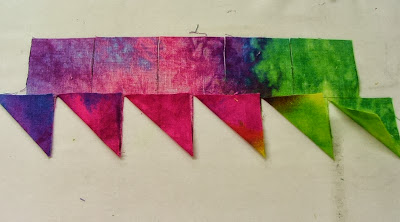ASIDE: My mother seems to be making yet
another of her miraculous recoveries, so much so that we are calling her Doris
Mandela!! Although she is not out of hospital yet, she is determined to get
back home and is working on her mobility with the hospital staff. I feel as if
she is taking four steps away from us but only three back each time she has
these medical emergencies. That said, I greatly admire her tenacity and I am
banking on the inherited genes!
During these
fraught few weeks, I have immersed myself in colour and fabric as a way of
coping. As usual with my own work, I have a vague idea of how I am going to
start but I have no idea where it will lead me and how it will end. I just let
the fabrics talk to me.
I prepare my
fabrics, preferring the close weave of multi-coloured Batiks and Bali’s, with a
fusible backing (Bondaweb is my preference) and use them like a paint palette.
My work area consists of a flat ironing surface covered with the release paper
removed from the fusible web. I cut random strips of fused fabrics using a
rotary cutter and a pinked blade.
I prepare
squares from the fused fabric, where the strips are placed on the diagonal and
over-lapped slightly so that they stick to each other when ironed. On the design wall, which is essential for this
process, I over-lap and fuse these squares together to create larger squares. The
square on the design wall below measures 18” with a 6” squares missing from the
centre. (ASIDE: The first square I made like this was put
forward as one of the ideas for our group quilt project but it was rejected. It
seems too good an idea to drop so I am developing it myself.)
The concept
is to create a wash of colour going across the whole quilt, so that the colours
of one square and one block seep into the colours of another. I liken the
process to doing a jigsaw, where you have to find the right strip of fabric for
the right place. The process isn’t easy and it requires a lot of prepared fabric
strips for ease of creativity.
Before I
fuse a fabric, I pin it onto the design wall and audition it for colour and
tone. Taking a photograph helps to distance you from your work so that you can view
the blocks as a whole and therefore make better colour choices.
The preparation goes hand in hand with ironing. Once I have
selected my palette of fabric, I stick them, RS up, onto the glue side of the
fusible web, over-lapping them slightly so that no fusible gets onto the iron.
Completed sheet
Allow the fabrics to cool and only then start to
remove the release paper from the fabric. This paper makes an excellent surface
for sticking over-lapping shapes, so remove it carefully so you can re-use it.
I slide my hand between the layers initially and work across from edge to edge.
I then pull the paper from the fabric, taking care
that it doesn’t rip.
Once free from its paper, the individual fabric pieces
can be easily separated.
On the WS of the fabric you will be able to see
where the fabrics over-lapped and where there is no fusible.
Use a pinked blade and cut away the fabric which is
not fused.

























































